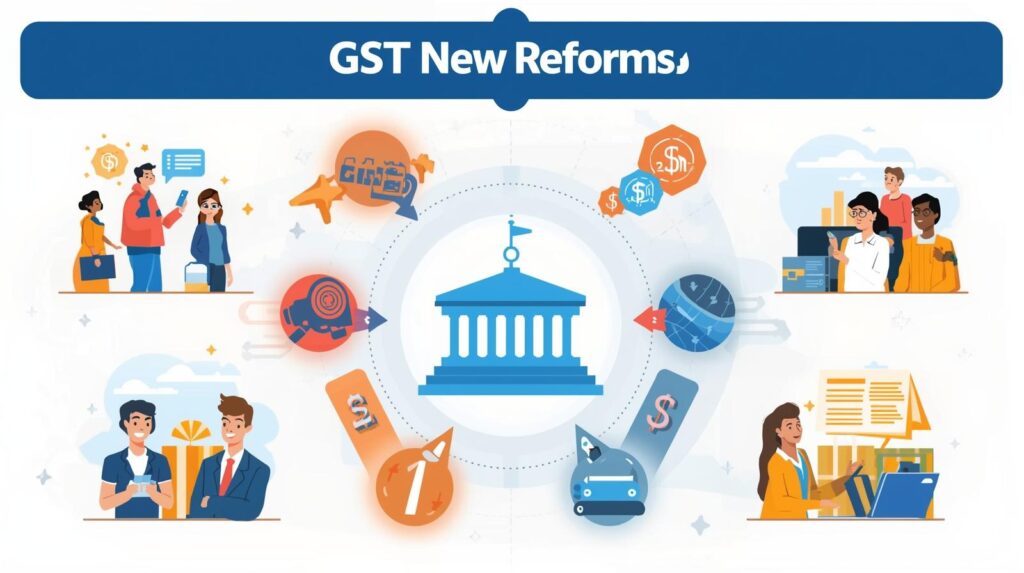
In a historic reform, the GST Council in its 56th meeting approved a sweeping rationalisation of India’s Goods & Services Tax structure. Effective from 22nd September 2025, the previous four-slab system (5%, 12%, 18%, 28%) has been streamlined into:
- 5% (merit rate) for essential goods and services
- 18% (standard rate) for most products
- 40% (de-merit rate) for luxury and sin goods
1. What Changed? New vs Old GST Rates
- Simplified slab system: Eliminated the 12% and 28% tiers to reduce complexity.
- Expanded merit rate coverage: Items like personal care goods, footwear, textiles, kitchenware, renewable energy components moved to 5%.
- Automotive relief: Small cars and sub-350cc motorcycles now taxed at 18%, down from 28%. Larger vehicles and premium bikes fall under 40%.
- Energy and appliances: TVs, ACs, dishwashers reduced to 18%; renewable energy products (e.g., solar, wind) now at 5%.
- Entertainment and insurance: Basic entertainment services and insurance now enjoy 5% or full exemption. Adds clarity and reduces compliance burden.
- High-rated items: Tobacco, high-end cars, sugary drinks, pan masala, lotteries shifted to 40%.
2. What Goods & Services Are Affected?
| Category | Old Rate(s) | New Rate |
|---|---|---|
| Daily essentials (soap, toothpaste) | 18% | 5% (merit rate) |
| Food, textiles, footwear | 12% / 18% | 5% |
| Appliances, TVs, auto parts | 28% | 18% |
| Small cars, sub-350cc bikes | 28% | 18% |
| Renewable energy equipment | 12% | 5% |
| Insurance (life, health) | 18% | Exempt |
| Luxury cars, sin goods | 28% or 18% + cess | 40% (de-merit rate) |
Essentials and common household items now enjoy far lower taxes, directly easing consumer costs.
Automotive sector sees mixed impact: affordability for small vehicles improves, while luxury segments face higher tax.
Renewable energy projects become more cost-efficient, boosting green energy transition.
Moviegoers see marginal relief on tickets under ₹100, taxed at 5%, but no change for premium seats.
Apparel under ₹2,500 now taxed at 5%, making everyday clothing cheaper. Branded, higher-priced apparel sees increased 18% tax.
3. Implementation & Timeline
- Effective date: GST rate changes apply from 22nd September 2025, for most goods and services.
- Exception: Items like pan masala, tobacco and related products continue under old rates until cess liabilities are cleared; transitional timeline to be announced.
- Process: Reforms introduced as part of broader “GST 2.0” initiative, aiming for smoother tax administration.
4. Sectoral Impacts & Economic Outlook
- Expected to reduce inflation by up to 1.1 percentage points, according to analysts.
- Companies like Raymond Lifestyle are taking immediate action to lower prices across ~2/3 of their offerings under the new 5% slab.
- The tax relief could stimulate spending, particularly during the festive season, boosting retail and consumer durable sectors.
- Distributed tax burden incentivizes green energy adoption, improving investment viability.
Conclusion
India’s monumental GST overhaul represents a milestone in simplifying taxation and promoting equitable growth. Reduced rates on essential goods, energy, and consumer durables are set to ease household budgets, while the higher rate for luxury and sin goods supports fiscal prudence.


